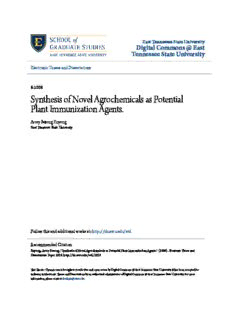
Synthesis of Novel Agrochemicals as Potential Plant Immunization Agents. PDF
Preview Synthesis of Novel Agrochemicals as Potential Plant Immunization Agents.
East Tennessee State University Digital Commons @ East Tennessee State University Electronic Theses and Dissertations Student Works 8-2008 Synthesis of Novel Agrochemicals as Potential Plant Immunization Agents. Arrey Besong Enyong East Tennessee State University Follow this and additional works at:https://dc.etsu.edu/etd Part of thePlant Pathology Commons Recommended Citation Enyong, Arrey Besong, "Synthesis of Novel Agrochemicals as Potential Plant Immunization Agents." (2008).Electronic Theses and Dissertations.Paper 1959. https://dc.etsu.edu/etd/1959 This Thesis - Open Access is brought to you for free and open access by the Student Works at Digital Commons @ East Tennessee State University. It has been accepted for inclusion in Electronic Theses and Dissertations by an authorized administrator of Digital Commons @ East Tennessee State University. For more information, please [email protected]. Synthesis of Novel Agrochemicals as Potential Plant Immunization Agents A thesis presented to the faculty of the Department of Chemistry East Tennessee State University In partial fulfillment of the requirements for the degree Master of Science in Chemistry by Arrey Besong Enyong August 2008 Yu‐Lin Jiang, Ph.D., Chair David Young, Ph.D Dhirendra Kumar, Ph.D Ismail Kady, Ph.D Keywords: SABP2, BTH, salicylic acid, plant immunization ABSTRACT Synthesis of Novel Agrochemicals as Potential Plant Immunization Agents by Arrey Besong Enyong The world’s population is expected to grow from 6 billion to about 10 billion by 2050. The greatest population increase is expected to occur in Africa, Latin America, and Asia. To feed a world with huge increases in population and to sustain the well‐being of humans, a large increase in food production must be achieved. The projected increase in food production must be accomplished on the existing cultivated areas because the expansion of new land is limited by environmental concerns, urbanization and increasing water scarcity. Different compounds have been developed for the “immunization” of plants against several pathogens. These compounds induce systemic acquired resistance (SAR) in plants, leading to broad‐based, long‐lasting resistance to a wide range of pathogens. The salicylic acid binding protein 2 (SABP 2) has been identified as a key enzyme in the salicylic acid mediated pathogen resistance pathway, converting methyl salicylate (MeSA) to salicylic acid (SA), a key compound responsible for SAR . S‐methyl benzo [1, 2, 3,] thiadiazole‐7‐carbothiate (BTH) was the first commercial compound used for plant immunization. We have synthesized and characterized some new salicylic acid derivatives [methyl‐2‐(2‐hydroxy benzoyl thio) acetate and derivatives], and we have studied the in‐vitro activity with SABP2 of BTH by HPLC analysis. 2 DEDICATION To my brother (R.I.P), my sisters and mom and dad. Love you all. 3 ACKNOWLEDGEMENTS I would like to say thanks to the Department of Chemistry here at East Tennessee State University for giving me the opportunity to pursue a graduate degree. This department has been like a door opening to many things to come. I would also like to thank the entire faculty and staff of the Department of Chemistry for their support and also for the knowledge imparted to me. Many thanks to my thesis committee especially to my supervisor and mentor Dr. Yu‐Lin Jiang for their time and patience. Thanks to Dr. Young, Dr. Kumar, and Dr. Kady for their time. Special thanks to my mom and dad, Mrs Regina and Dr. Peter Enyong, for their moral and financial support. Thanks to my three lovely sisters and to all my friends here at ETSU for all their support through thick and thin. 4 CONTENTS Page ABSTRACT ........................................................................................................................................ 2 DEDICATION .................................................................................................................................... 3 ACKNOWLEDGEMENTS…….…………………………………….………………………………………………………………….4 LIST OF FIGURES………………………………………………………………………………………………………………………..8 LIST OF SCHEMES…………………………………………….…………………………………………………………………………9 LIST OF TABLES…………………………………………………………………………………………….………………………….10 Chapter 1. INTRODUCTION………………………………………………….………………………………………………………………..10 Global Population and Food Demands……………….……..…………………………………………………10 Disease Resistance in Plants…………………..……………….……………………………………………………15 Salicylic Acid and Induction of Resistance Responses……………………….…………………………..17 Plant Defense Pathways………………………………………..…………………..…………………………………19 Bioactive Synthetic Analogues of Salicylic Acid………………………………….………………………….22 Structure‐Activity Studies of some Salicylic Acid Analogues………………………….………………26 BTH‐Derived Agrochemicals………………………………………………………………….……………………..28 2. RESULTS AND DISCUSSION…………………………………………………………………………………………….…...34 Synthesis of YAL 01……………………………………………..……………………………………………………….36 Synthesis of YAL 03………………………………………….…………………………………………………………..36 Synthesis of YAL 04…………………….………………………………………………………………………………..37 Synthesis of YAL 05………………………………………………………………………………………………………37 Kinetic Studies for BTH……………………………..………………………………………………………………….37 3. EXPERIMENTAL………………………………………………….…………………………………………………………………40 5 Materials and Methods……………………….……………………………………………………………………….40 Synthesis of YAL 01……………………………….……………………………………………………………………..41 Synthesis of YAL 04………………………………….…………………………………………………………………..42 Synthesis of YAL 03…………………………….………………………………………………………………………..43 Synthesis of YAL 05………………………….…………………………………………………………………………..44 Kinetic Studies of BTH…….…………………………………………………………………………………………….45 4. CONCLUSION……………………………………………..………………………………….……………………………………47 BIBLIOGRAPHY…………….………………………………………..…………………………………………………………………48 APPENDIXES………………………………………………………..…………………………………………………………………..50 Appendix A. 1H NMR Spectrum of YAL 01…………………….…………………………………………….. 50 Appendix B. 13C Spectrum for YAL 01……………………………..…………….……………………………..51 Appendix C. IR Spectrum of YAL 01……...………………………..……..…………………………….………52 Appendix D. 1H NMR Spectrum of YAL 03……………………….……………………………………………53 Appendix E. 13C Spectrum of YAL 03……………………………………..……………………………..………54 Appendix F. 1H NMR Spectrum of YAL 04…………………………………..………………………………..55 Appendix G. 13C Spectrum of YAL 04………………………………………….……………………..…………56 Appendix H. 1H NMR Spectrum of possibly YAL 05… …………………….…………………………....57 Appendix I. 13C Spectrum of possibly YAL 05….………………….………………………………..………58 Appendix J. Kinetic Studies of BTH……………………………….……………………………………….….…59 VITA…………………………………………………………………………………………..…………………………………………….60 6 LIST OF FIGURES Figure Page 1. Population of the World, Estimates and Projection Variants, 1950‐2050………………………….….10 2. Growth in Fertilizer Use and Cereal Production in Developing Countries During 1961‐ 1995………………………………………………………………………………….……………………………………..14 3. Schematic Representation of the SA‐Biosynthetic Pathway…………………………….…………………..21 4. Site of Action of ASM (CGA 245704) in the Signal Transduction Pathway……………………….…..24 5. Broad‐spectrum SAR Activation by ASM Against Diseases of Tobacco: Summary of Fields Trial Results with BION®/ ACTIGARD™ Used at 12‐37g per ha…………………………25 7 LIST OF SCHEMES Scheme Page 1. Synthetic Reaction Scheme for YAL Derivatives…………………………………………………..………………35 8 LIST OF TABLES Table Page 1. Population Projection in Some Major Continents by 2050………………………………..…………………11 2. Kinetic Data for BTH………………………………………………………………………………….………………….…….39 3. Turnover Number for BTH…………………………………………………………………………..……………………….39 9
Description: